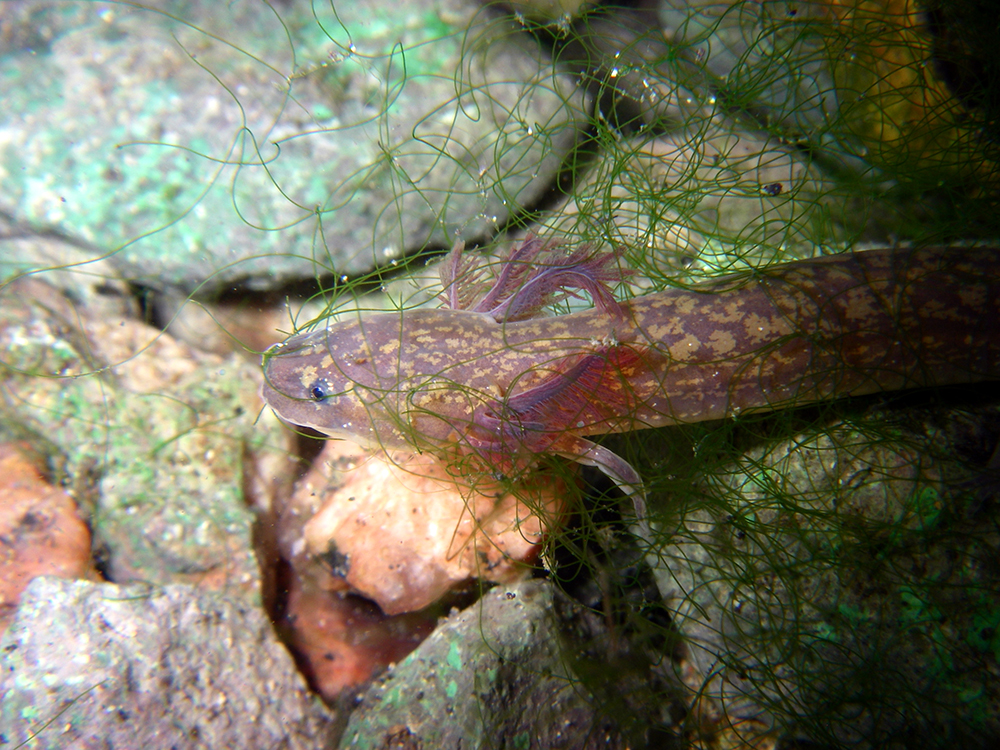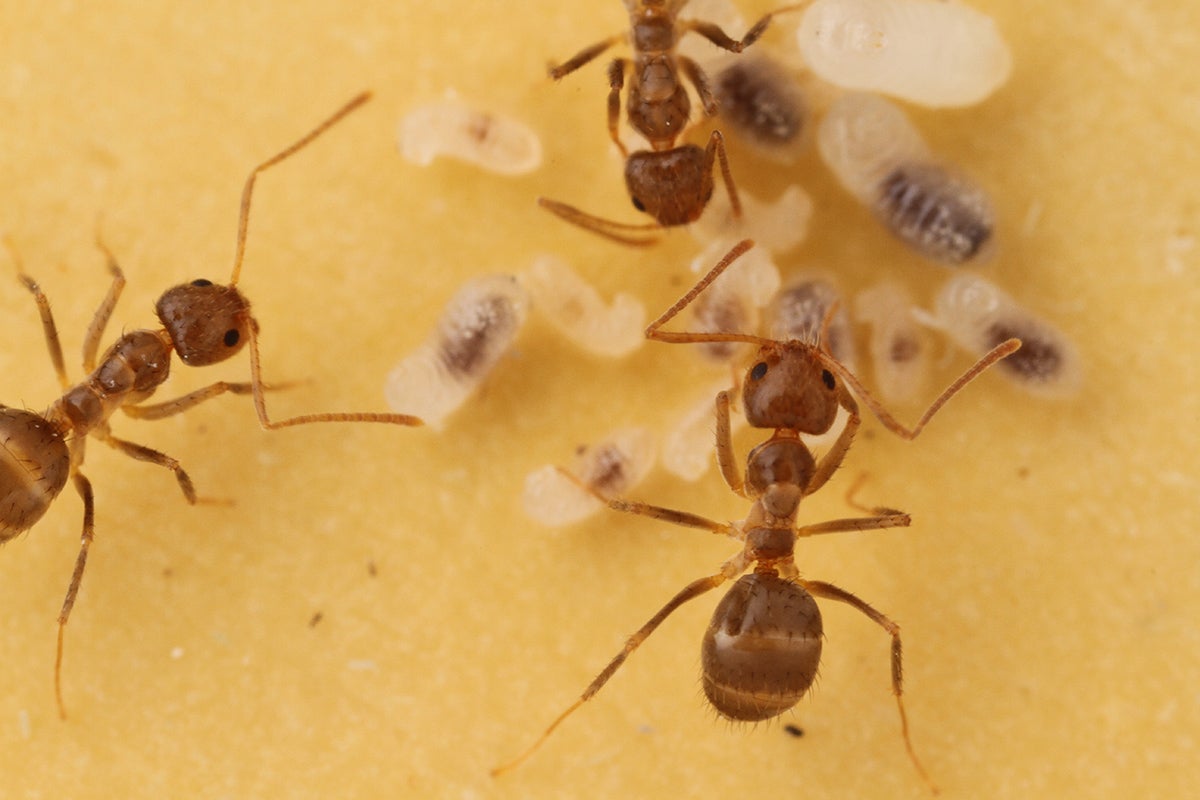Novel Method Reveals Diet of Endangered Barton Springs Salamander
Using a novel technique that is less invasive, less lethal, and more informative than traditional methods, an alumna of The University of Texas at Austin has identified what prey the endangered Barton Springs Salamander chooses to eat.

The Barton Springs Salamander (Eurycea sosorum) in Eliza Spring. Image courtesy of Hayley Gillespie.
Using a novel technique that is less invasive, less lethal, and more informative than traditional methods, an alumna of The University of Texas at Austin has identified what prey the endangered Barton Springs Salamander chooses to eat.
The salamander research and details on the new technique, called stable isotope analysis, were published in a recent study in the January 15 issue of PLOS ONE.
The Barton Springs Salamander (Eurycea sosorum) was officially designated as a separate species in 1993 and was placed on the federal List of Threatened and Endangered Species in 1997. Two of the three authors who described the new species were from UT Austin. They were Paul Chippendale, another UT alumnus, and David Hillis of the Section of Integrative Biology.
Conservation of endangered species like the Barton Springs Salamander depends on solid data regarding the life histories of these organisms. Amphibians, in decline throughout the world, are of particular interest because they play a large role in many ecosystems. In order to assess the effects of ecological disturbances, such as habitat destruction, invasive species, or climate change, we have to know what a species prefers and the narrowness of these preferences. Unfortunately, some species are harder to study than others, so data is often limited.
Stable isotope analysis appears to be an ideal way to gain more information by determining the diet of some endangered organisms, particularly amphibians.
“The basics behind the stable isotope approach is that ‘you are what you eat,’” said Dr. Hayley Gillespie, author of the study and recent alumna of the Ecology, Evolution, and Behavior graduate program. “This indirect method of studying diet lets us know the general proportion of different food items because the salamander tissue will take on the isotopic values of its prey.”
In preparing for the study, Gillespie sampled the small animal life in Eliza Spring, home to the largest known population of the Barton Springs Salamander. She determined the ratios of carbon-13 to carbon-12 and nitrogen-15 to nitrogen-14 for the most likely prey items which, based on size and availability at the time, were amphipods (tiny crustaceans), midge fly larvae, and planarian flatworms. She compared these isotope ratios with a sample snipped from the tail of each salamander.
Traditionally, the diets of animals have been determined through methods such as direct observation, gut analysis, or gastric lavage. Direct observation is difficult or even impossible for some species, like the Barton Springs Salamander, which lives under water and hides beneath rocks. Gut analysis requires dissection of the animal, making it inappropriate for an endangered animal. While gastric lavage, which uses water pumped through a small tube to flush the stomach contents, is not always successful and is often lethal for smaller animals. In addition, these traditional methods give just a snapshot of what the animal eats, as opposed to stable isotope analysis, which yields a long-term picture of the creature’s diet.
“When I first started learning about these salamanders there were only a few anecdotal observations…. Several people I talked to assumed that E. sosorum - like many other salamanders - would just eat anything that arrived in front of their face. But the isotope data shows otherwise - they do seem to be making foraging decisions based on preference rather than availability.”
The salamanders showed a definite preference for flatworms, despite the fact that amphipods were often 10 to 50 times as plentiful. Gillespie also found that the salamander would switch to other prey when flatworms were scarce. Her results were supported by anecdotal observations from a colleague, Raoul Manenti, who studies aquatic salamanders in the Appenine Mountains of Italy. The landscape there is similar to Texas’ Edwards Aquifer ecosystem, of which Barton Springs is a part. Manenti noted two different salamander species that fed on flatworms.
“Thus, our independent observations combined suggest that planarians may be an important but overlooked prey item for aquatic salamander species. It’s fun making those kinds of connections and learning that someone else on the other side of the planet, studying a very similar ecosystem to the one you study, has observed similar findings as you. These are the patterns in natural systems that ecologists strive to describe, study, and make sense out of.”
In the future, Gillespie would like to adapt this method so that it makes even less of an impact on the Barton Springs Salamander and other amphibians.
“I have some studies planned on developing a method to measure stable isotopes from the mucous coat of amphibians - which would be even less invasive than the tail clips. This method has been developed with earthworms and small fish, but I think it would be great for amphibians because they don’t always have a tail to clip (frogs), and you still can’t really clip tails of the juveniles - it just requires too much tissue. This method basically involves putting the salamander in a baggie with water so that it sheds mucous into the water. You then filter the water on a glass filter and measure the stable isotope values from the mucous-coated filter!”
Gillespie is certain that this new method will be of great value to conservation biology.
“I would like for other researchers of endangered species to know that there are alternative methods to studying species interactions that are non-lethal. So much of dietary analysis involves killing and dissecting the animal you’re studying and with endangered species that’s just not really an option. This type of limitation is one reason we sometimes know very little about the ecological requirements of endangered species.”
Hayley also believes in the importance of communicating about science to the public.
“I think it’s important for people to know that we have these endangered species in our own backyard - and that there is a community of researchers who have been studying them for a long time, who are a part of their local community. I grew up in Texas, and first learned about the salamanders on family vacations to Barton Springs and Aquarena Springs. When I got to grad school I thought we’d know everything there is to know about them by now...but we didn’t have many studies about their diet, or about many ecological interactions, and we still have a lot to learn. This study is just one example of how scientists are using exciting technologies to study endangered species.”
While Gillespie attended UT Austin, she studied under Camille Parmesan of the Section of Integrative Biology. All of the work for this study was conducted as part of her graduate studies at UT. She is currently teaching field ecology as a part time assistant professor for Southwestern University in Georgetown. She is also the owner and director of Art.Science.Gallery. in Austin, which features science-related visual arts exhibitions and serves as a science communication training center.



